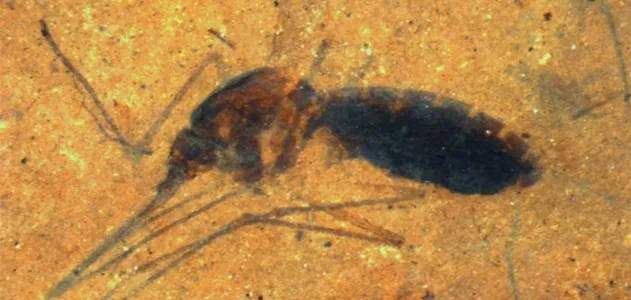The Incredible Survival Story of Mosquitoes
Outlasting the Mighty T. rex
Remember that annoying mosquito that kept you up last night? Believe it or not, it belongs to a lineage that stretches back over 130 million years. This is long before humans existed and even before many dinosaurs walked the Earth. While Tyrannosaurus rex vanished 66 million years ago, insects closely related to modern mosquitoes have survived asteroid impacts, ice ages and mass extinctions.

Image By Dane Greenwalt
Nature's Ultimate Survivors
Imagine this: an asteroid strikes Earth, dust blocks the sun, temperatures plummet and most dinosaurs perish. Yet tiny insects like mosquitoes survive. How did something so small and fragile outlast creatures far larger and stronger?
Mosquitoes or their ancient relatives had key advantages:
- They reproduce quickly and adapt to changing environments.
- They need minimal resources, such as a small amount of standing water and an occasional nutrient source.
- They thrive in diverse habitats, from tropical rainforests to the Arctic tundra.
- Their piercing mouthparts, which evolved early, allowed them to exploit new food sources.
Remarkably, their basic body plan has changed little over millions of years. Fossils found in amber show insects that look strikingly similar to the ones buzzing around your backyard today.
Pushing Back the Mosquito Clock
Until recently, scientists believed the oldest mosquitoes dated back about 90 to 100 million years, based on fossils from the Late Cretaceous. But in 2023, a groundbreaking discovery in Lebanese amber changed everything.
Researchers found two male mosquitoes named Libanoculex intermedius, dating back 136 million years. This makes them the oldest mosquito-like insects ever discovered. These fossils had sharp, tooth-like mandibles and laciniae, suggesting they could pierce surfaces.
While modern male mosquitoes feed on nectar, these ancient males may have been hematophagous, meaning they could have fed on blood. However, there is no direct evidence that they actually did. The idea is based only on their anatomy.
This discovery pushes the origin of mosquitoes or their immediate ancestors back to the Early Cretaceous. It confirms that mosquito-like insects lived alongside dinosaurs for tens of millions of years.
A Mix of Ancient and Modern Traits
Another important fossil, Burmaculex antiquus, found in Burmese amber 90 to 100 million years old, shows a mix of primitive and modern features. This helps scientists trace how blood-feeding behavior evolved in mosquitoes.
Together, these fossils show that the tools for biting, such as piercing mouthparts, evolved very early. They may have started as an adaptation for feeding on plant fluids before shifting to vertebrate blood.
The Mosquito Timeline: Key Fossil Discoveries
Fossil evidence reveals a growing timeline of mosquito evolution:
- 136 million years ago: Libanoculex intermedius in Lebanese amber, the oldest known mosquito-like insect.
- 100 to 90 million years ago: Burmaculex antiquus in Burmese amber, showing early signs of modern mosquito traits.
- 78 million years ago: Mosquitoes preserved in Canadian amber.
- 46 million years ago: A fossil mosquito from Montana, USA, preserved chemical traces of a blood meal.
These insects shared the planet with dinosaurs for at least 70 million years. While we cannot know for sure, it is highly plausible that they fed on dinosaurs, just as they feed on us today.
Blood Traces Preserved for 46 Million Years
The Montana fossil is unique. After feeding, the mosquito landed in a prehistoric lake, sank into oxygen-poor mud and was perfectly preserved in shale.
Researchers analyzed its abdomen and found high concentrations of iron and porphyrins. These are molecular remnants of heme, the oxygen-carrying component of blood. This confirms the insect had recently consumed a blood meal.
However, no DNA survived. DNA breaks down completely after about 1.5 million years, even under ideal conditions.
Jurassic Park? Not So Fast
Despite what Hollywood suggests, we cannot clone dinosaurs from ancient blood in mosquitoes. The DNA is simply gone. But these fossils give us valuable insights into how blood-feeding evolved and how long mosquitoes have been interacting with vertebrates.
The Story Continues
Every new fossil adds a piece to the puzzle. Next time a mosquito lands on you, take a moment to appreciate its ancient legacy. These tiny survivors have witnessed the rise and fall of entire species, adapting and enduring through Earth's most dramatic changes.
Their story is not just written in genes. It is preserved in stone.
Further Reading and References
Greenwalt, D. E., et al. (2013). Hemoglobin-derived porphyrins preserved in a Middle Eocene blood-engorged mosquito. Proceedings of the National Academy of Sciences, 110(44), 17846–17851.
https://doi.org/10.1073/pnas.1310885110Smithsonian Magazine. A Fossilized Blood-Engorged Mosquito Is Found for the First Time Ever.
https://www.smithsonianmag.com/science-nature/a-fossilized-blood-engorged-mosquito-is-found-for-the-first-time-ever-1749788/
